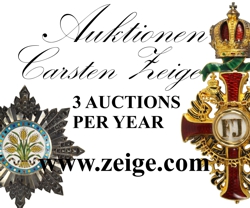Military Order of the Tower and the Sword, Type III, Grand Officer Neck Badge
SKU: 01.PRT.0101.308.01
Estimated market value:

Estimated market value:
Attributes
History
The Military Order of the Tower and Sword, Valour, Loyalty and Merit (Ordem Militar da Torre e Espada, Valor, Lealdade e Mérito) was established as Military Order of the Tower and Sword in Rio de Janeiro by Prince Regent John, the future King John VI, in 1808. It was instituted in commemoration of the safe voyage of the Royal Family from Portugal to Brazil following the invasion of Napoleon's troops in 1807.
Founded with three grades, Grand Cross, Commander, and Knight, the Order was expressly created as a non-religious decoration in order for the Prince Regent to reward the non-Catholic British Royal Navy who escorted the Portuguese Royal Family on their voyage. It was the first Order of Merit without connection of the Catholic Church granted by the Portuguese Crown.
Originally, the Grand Cross was limited to 12 members while the other grades had not limit. In 1809, the Commander was limited to 24 members and the Knight was limited to 100.
The Order's name was taken from an older Portuguese order called Order of the Sword that was created by King Alfonso V in 1459. Some resources stand that the Order of the Tower and Sword, Valour, Loyalty and Merit was a revival of this antique order; however, there is limited information to confirm this claim.
Besides the British Royal Navy, diplomatic corps credited at the Court in Rio de Janeiro, Officers and high dignitaries – Ministers and Secretaries of State, as well as Councillors of State, were the first recipients of this Order. These awards were manufactured in the Central Mint of Rio de Janeiro during 1808 and 1809. Since 1810, the Order's insignia and star have displayed a central blue border with the motto on it.
During the Peninsular War (1808-1814), many decoration were granted to military personnel from the British, Spanish, and Portuguese Armies.
Returned to Portugal, during the Liberal Wars (1828–34), many decoration were awarded by both sides of the conflict – the liberal constitutionalists and conservative absolutists. On this occasion, there were two different Orders of the Tower and Sword granted in Portugal, each one with their own grades and statutes. The new Order was linked to the conservative King Miguel I, while the old Order was awarded by King Pedro in name of the Queen of the liberal monarchy, Maria II. In 1832, the Order was amended by King Pedro to make a difference between the two Orders; the Order's name was changed to Antique and Most Noble Military Order of the Tower and Sword, Valour, Loyalty and Merit.
More grades were added over the Order's lifespan; the Officer was added in 1832, the Grand Officer was added in 1896, and the Grand Collar was added in 1939.
This Order was the only Military Portuguese Order that was not abolished by the Republic Revolution in 1910.
Currently, it is active in Portugal and it is conferred in recognition of meritorious command of military troops and outstanding merit in the highest government offices. It is also conferred upon Portuguese civilians and military personnel in recognition of acts of heroism and exceptional acts of courage and sacrifice that have benefited the nation and humankind. The President of the Portuguese Republic is Grand Master.
In order of precedence, it is the highest decoration granted by the Portuguese government over the Order of Christ.
The Military Order of the Tower and the Sword has undergone various changes in name, grades, and design since its inception. From 1808-1832, it was called the Order of the Tower and Sword, and from 1832-1917, it was called the Ancient and Most Noble Order of the Tower and of the Sword, of Valour, Loyalty, and Merit. Since 1917, it is known as Order of the Tower and Sword.
The Order is classified into three types based on design changes outlined in official statutes. Type I (1808-1832) decorations feature the portrait of Prince Regent John in the obverse medallion and a wreath with a sword in the reverse medallion, Type II (1833-1917) decorations feature a wreath and sword in the obverse medallion and an open book in the reverse medallion, and Type III (1917-) decorations feature a wreath and sword in the obverse medallion and the Portuguese coat of arms in the reverse medallion.
In Type III, the royal symbols were suppressed from the insignia by the Republican government.

Versions
N/A
Silver gilt/Enamelled
Obv: VALOR LEALDADE E MERITO Rev: REPUBLICA PORTUGUESA


Comments
Sign in to comment and reply.


Scroll Top